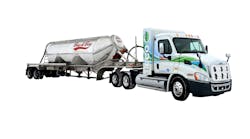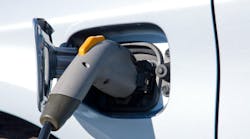For Bay & Bay Transportation, when it came time to invest in two alternative-fuel tractors, it was a color that drew its attention. While the logo for the Rosemount, MN-based fleet is red, it was the potential green—both the environmental and financial green—that the Cummins Westport ISX12 G compressed natural gas engine (CNG) could provide that garnered the most attention.
The powerplant in Bay & Bay’s two Freightliner Cascadia tractors is capable of producing up to 400 hp. and 1,450 lbs.-ft. of torque with a displacement of 11.9L. The vehicles each hold 140 diesel gallon equivalent for a driving range of about 450 mi.
“We’re definitely an [early] adopter of this alternative fuels technology, but it’s worth the investment. We’re committed to trucks that run cleaner and use less fuel,” says Sam Anderson, president and CEO of Bay & Bay.
Founded in 1941, Bay & Bay’s 500-truck fleet provides asset-based 3PL services for refrigerated, dry van, dry tank, flatbed, LTL and intermodal shipments in the U.S. and Canada.
One item that particularly appealed to the company was the ability of the engine to produce power and torque nearly equivalent to a diesel-powered truck.
“These trucks have as much torque and hauling capacity as their diesel equivalent but with lower fuel costs, lower carbon emissions, and higher driver satisfaction,” Anderson says. “We’re especially proud of lowering our carbon footprint. These trucks are another step in our efforts to be mindful of the environment.”
The trucks are running short-haul routes in Minnesota and Wisconsin 22 hours a day, seven days a week, the company said. And while Bay & Bay is monitoring the performance of the vehicles, it is still too early to draw any definite conclusions, Anderson says.
MORE DATA NEEDED
“We are having to change oil two to three times more frequently than our current diesel trucks,” Anderson says. “Miles per gallon are less than the diesel trucks, but the current data is not reliable due to the break-in period of the engines.
“We want to get at least eight months of data and then will look at adding more CNG trucks,” he relates, noting that the company could add an “additional 20 trucks at least in the next two years, [but] it could be as high as 40.”
The vehicles cost about 50% more than a comparable diesel truck, but Bay & Bay anticipates a 50-80% reduction in carbon emissions per truck in addition to the fuel savings obtained from using CNG, which is $2 or more cheaper than diesel in some areas.
The ISX12 G uses the same stoichiometric cooled exhaust gas recirculation (EGR) combustion technology, spark ignition, and simple three-way catalyst aftertreatment as the Cummins Westport ISL G 9L natural gas engine, first introduced in 2007. The larger, more powerful model is built on the same assembly line as the ISX diesel engines and shares many of the same components, Cummins said.
The cooled EGR combustion technology uses a measured quantity of exhaust gas and passes it through a cooler to reduce the temperature before mixing it with fuel and the incoming air charge to the cylinder. According to Cummins, the use of cooled EGR in combination with stoichiometric combustion improves power density and fuel economy. Diesel particulate filters or selective catalytic reduction systems are not required.
To date, he says the vehicles live “up to expectations as they relate to pulling heavy loads and going up and down hills.”
There has been at least one surprise in the early going, Anderson says. “The drivers enjoy driving them [for] two reasons: they are really quiet and the drivers don’t smell like diesel fuel when they get home at night.”
Where Bay & Bay goes with natural gas will depend on the performance and reliability of the Freightliner Cascadias and their Cummins Westport ISX12 G engines—and ultimately on the return on investment—but there is now a potential to save plenty of green going forward.



